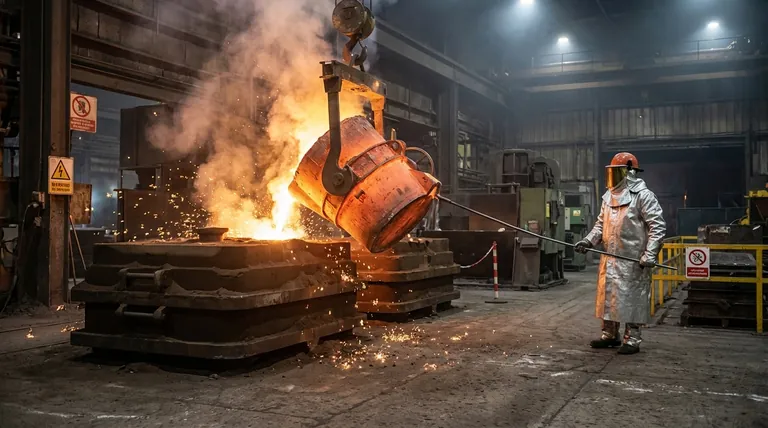용융 금속의 주요 위험 요소는 심각한 화상을 훨씬 넘어섭니다. 여기에는 치명적인 증기 폭발, 유독성 가스 및 연기 방출, 강렬한 복사열, 상당한 화재 위험이 포함됩니다. 이러한 각 위험 요소를 이해하는 것은 안전한 작업 환경을 구축하는 데 매우 중요합니다.
용융 금속과 관련된 가장 심각한 사고는 직접적인 접촉이라는 명백한 위험으로 인해 발생하는 경우가 거의 없습니다. 대신, 간과된 2차 위험 요소, 특히 금속과 작고 사소해 보이는 물의 상호 작용으로 인해 촉발되는 경우가 많습니다.
열 위험의 스펙트럼
용융 금속의 가장 직관적인 위험은 극심한 온도입니다. 예를 들어, 강철은 약 2800°F(1538°C)에서 취급됩니다. 이러한 온도는 여러 층의 열적 위험을 생성합니다.
직접 접촉 화상
용융 금속이 피부에 튀거나 쏟아지면 즉각적이고 깊으며 생명을 위협하는 화상을 입힙니다. 금속의 높은 열용량은 매우 빠르게 막대한 양의 에너지를 전달한다는 것을 의미합니다.
일반 의류는 보호 기능을 제공하지 않으며 피부에 녹아 붙어 부상을 악화시킬 수 있습니다.
복사열 노출
용융 금속에 닿지 않아도 해를 입을 수 있습니다. 용광로, 국자, 금속 자체에서 강렬한 적외선 에너지가 방출됩니다.
이 복사열은 먼 거리에서도 심각한 화상을 입히고, 시력을 손상시키며, 시간이 지남에 따라 열 스트레스, 탈진 및 탈수를 유발하여 판단력과 신체 능력을 저하시킬 수 있습니다.
화재 및 점화 위험
용융 금속이 쏟아지면 접촉하는 모든 가연성 물질에 즉시 불이 붙습니다. 여기에는 목재, 종이, 판지, 인화성 액체 및 유압유가 포함됩니다.
이러한 위험에는 완벽한 정리 정돈과 용해로, 주조장 또는 주조 구역에 있는 모든 재료에 대한 신중한 감사가 필요합니다.

폭발 반응의 치명적인 위험
치명적인 사건이 발생할 수 있는 가장 큰 잠재력은 용융 금속과 물 또는 기타 액체의 상호 작용에서 비롯됩니다. 이는 모든 강력한 안전 프로그램의 주요 초점입니다.
증기 폭발 설명
용융 금속이 물을 감싸면 물이 빠르게 증기로 변합니다. 이러한 상 변화에는 격렬한 팽창이 수반되며, 물은 거의 즉각적으로 부피가 1,600배 이상 증가합니다.
이는 강력한 폭발을 일으켜 수 톤의 용융 금속과 장비 파편을 넓은 지역에 날려 보낼 수 있으며, 이는 치명적인 결과를 초래합니다. 유발 요인은 국자에 떨어지는 소량의 물이나 바닥의 웅덩이에 떨어진 작은 유출물일 수 있습니다.
물 오염의 일반적인 출처
증기 폭발을 방지하려면 습기에 대한 강박적인 경계가 필요합니다. 주요 출처는 다음과 같습니다.
- 용광로에 투입되는 축축하거나 젖은 스크랩 금속.
- 용융물에 투입되는 젖은 도구, 금형 또는 기구.
- 수냉식 용광로 패널 또는 장비의 누수.
- 비, 청소 또는 누수로 인한 바닥의 웅덩이.
- 천장 파이프 또는 지붕에서 떨어지는 응결수.
밀폐 공간의 영향
구덩이, 트렌치 또는 기타 밀폐된 공간에서 발생하는 증기 폭발은 훨씬 더 위험합니다. 폭발력은 집중되고 방향성이 있어 파괴력을 증폭시킵니다.
대기 및 화학적 위험
보이지 않는 것이 똑같이 위험할 수 있습니다. 금속을 녹이면 공기 중으로 다양한 보이지 않는 강력한 위험 요소가 방출됩니다.
유독성 연기 및 금속 증기
금속을 녹는점까지 가열하면 연기와 증기가 방출됩니다. 특정 위험은 가공 중인 합금에 따라 다릅니다.
아연, 카드뮴, 납, 망간과 같은 금속은 유독성 연기를 생성할 수 있습니다. 이를 흡입하면 즉각적인 질병(금속 흄열과 같은)이 발생하거나 신경계 및 내부 장기에 영향을 미치는 장기적인 만성 건강 손상으로 이어질 수 있습니다.
질식 위험
많은 용해 공정에서는 용융 금속을 산소로부터 보호하고 산화를 방지하기 위해 아르곤 또는 질소와 같은 불활성 가스를 사용합니다.
밀폐되거나 환기가 잘 안 되는 공간에서는 이러한 가스가 공기 중의 산소를 대체할 수 있습니다. 이는 경고 없이 의식을 잃을 수 있으므로 조용하고 치명적인 질식 위험을 만듭니다.
플럭스 및 슬래그로 인한 화학적 화상
불순물을 제거하기 위해 용융물에 플럭스(flux)라고 하는 물질이 종종 첨가됩니다. 결과적으로 발생하는 폐기물인 슬래그(slag)도 극도로 높은 온도에 있습니다.
플럭스와 슬래그 모두 부식성이 매우 강하거나 산성일 수 있습니다. 튀면 화학적 화상에 열 화상이 더해져 치료가 복잡해지고 부상이 악화됩니다.
일반적인 함정과 오해
진정한 안전은 기본적인 인식 수준을 넘어 안전 프로토콜의 일반적인 실패 지점을 이해하는 데 있습니다.
"사소한" 유출이라는 신화
안전하거나 사소한 유출은 존재하지 않습니다. 소량의 용융 금속이라도 물 공급원을 찾으면 치명적인 증기 폭발을 일으킬 수 있습니다. 모든 유출은 통제되지 않은 고위험 이벤트입니다.
2차 점화 간과
작업자는 종종 국자와 붓기에 집중하여 2차 화재 위험을 간과하게 됩니다. 작은 튀김도 놀라울 정도로 멀리까지 퍼져서 잊어버린 기름 묻은 헝겊 더미나 누출되는 유압 라인을 쉽게 찾을 수 있습니다.
부적절한 개인 보호 장비(PPE)
표준 면 또는 폴리에스터 의류를 사용하는 것은 심각한 실수입니다. 알루미늄 코팅 처리된 의류 또는 기타 난연성 의류와 같은 특수 PPE만 착용해야 합니다. 이 장비는 용융 금속 튀김을 흘려보내고 점화를 방지하도록 설계되어 탈출할 수 있는 중요한 몇 초를 제공합니다.
안주 및 위험 정상화
이러한 위험 요소 주변에서 매일 작업하는 시설에서는 위험에 대한 위험한 친숙함이 생길 수 있습니다. 이러한 "위험의 정상화"는 지름길, 소홀히 된 절차, 경계심 있는 안전 문화로부터의 이탈로 이어집니다.
용융 금속 안전에 대한 사전 예방적 접근 방식
성공적인 안전 전략을 구현하는 것은 각 특정 위험에 대한 방어 계층을 구축하는 것입니다.
- 치명적인 사건 방지에 중점을 둔다면: 용융 금속을 취급하거나 운반하는 모든 구역에서 물과 습기를 절대적으로 제거하는 것을 최우선으로 하십시오.
- 장기적인 작업자 건강 보호에 중점을 둔다면: 유독성 연기 및 금속 증기 노출을 제어하기 위해 강력한 환기 시스템 및 공기질 모니터링을 구현하고 유지 관리하십시오.
- 일일 운영 안전에 중점을 둔다면: 해당 구역의 모든 인력에게 적절하고 특수한 PPE 착용을 의무화하고 비상 절차에 대한 엄격하고 지속적인 교육을 수행하십시오.
이러한 위험 요소를 마스터하는 것은 두려움을 통해서가 아니라 공정에 대한 깊은 존중과 모든 단계에서 안전에 대한 훈련된 노력을 통해서 달성됩니다.
요약표:
| 위험 범주 | 주요 위험 요소 | 주요 예방 초점 |
|---|---|---|
| 폭발 반응 | 물 접촉으로 인한 증기 폭발 | 모든 습기 공급원 제거 |
| 열 위험 | 심각한 화상, 복사열, 화재 | 특수 PPE 사용, 구역 청결 유지 |
| 대기 위험 | 유독성 금속 연기, 질식 위험 | 강력한 환기 및 가스 모니터링 구현 |
| 화학적 위험 | 부식성 플럭스 및 슬래그로 인한 화상 | 적절한 보호 장비로 취급 |
팀과 시설을 치명적인 용융 금속 위험으로부터 보호하십시오. KINTEK은 고온 금속 가공에 필요한 강력한 실험실 장비 및 안전 소모품 제공을 전문으로 합니다. 당사의 용광로, PPE 및 흄 추출 시스템은 최대의 안전성과 신뢰성을 위해 설계되었습니다. 안전을 우연에 맡기지 마십시오. 폭발, 유독성 연기 및 열 위험으로부터 운영을 보호하려면 지금 전문가에게 문의하십시오.
시각적 가이드

관련 제품
- 회전식 튜브 퍼니스 분할 다중 가열 구역 회전식 튜브 퍼니스
- 진공 밀봉 연속 작동 회전 튜브로 진공 회전 튜브로
- 1400℃ 실험실용 알루미나 튜브 머플로
- 실험실 진공 틸트 회전 튜브 퍼니스 회전 튜브 퍼니스
- 수직 실험실 석영 튜브 퍼니스 튜브형 퍼니스



















